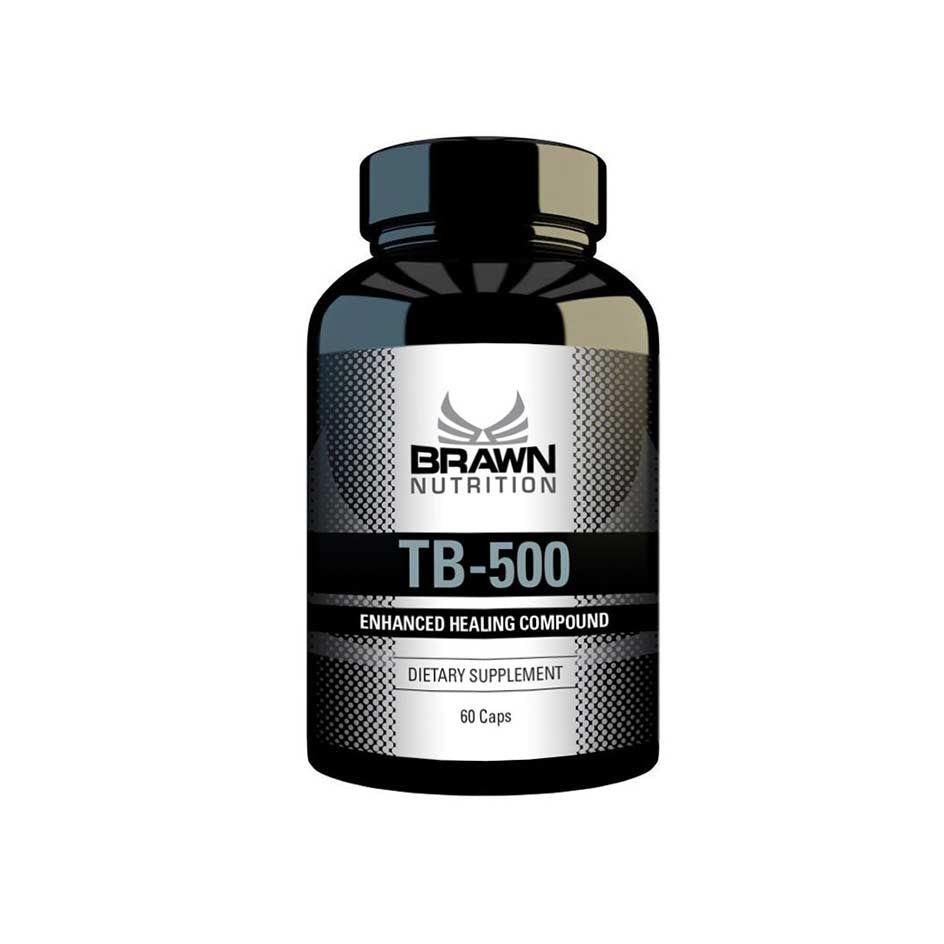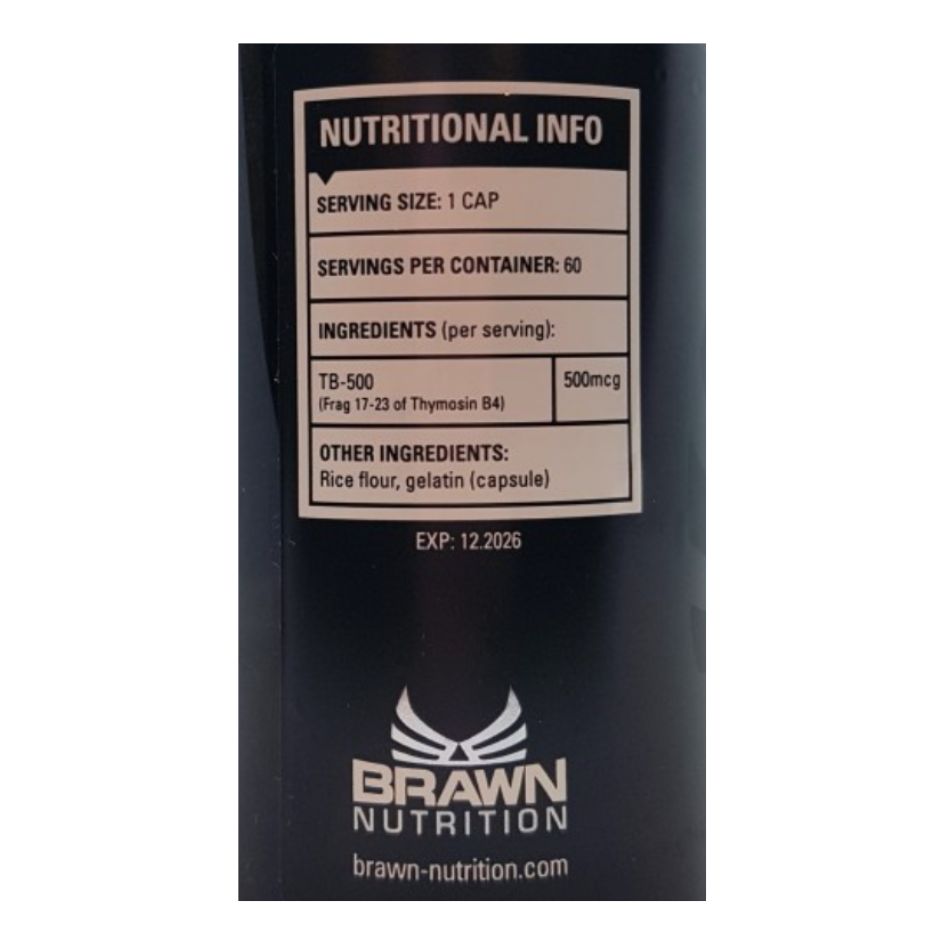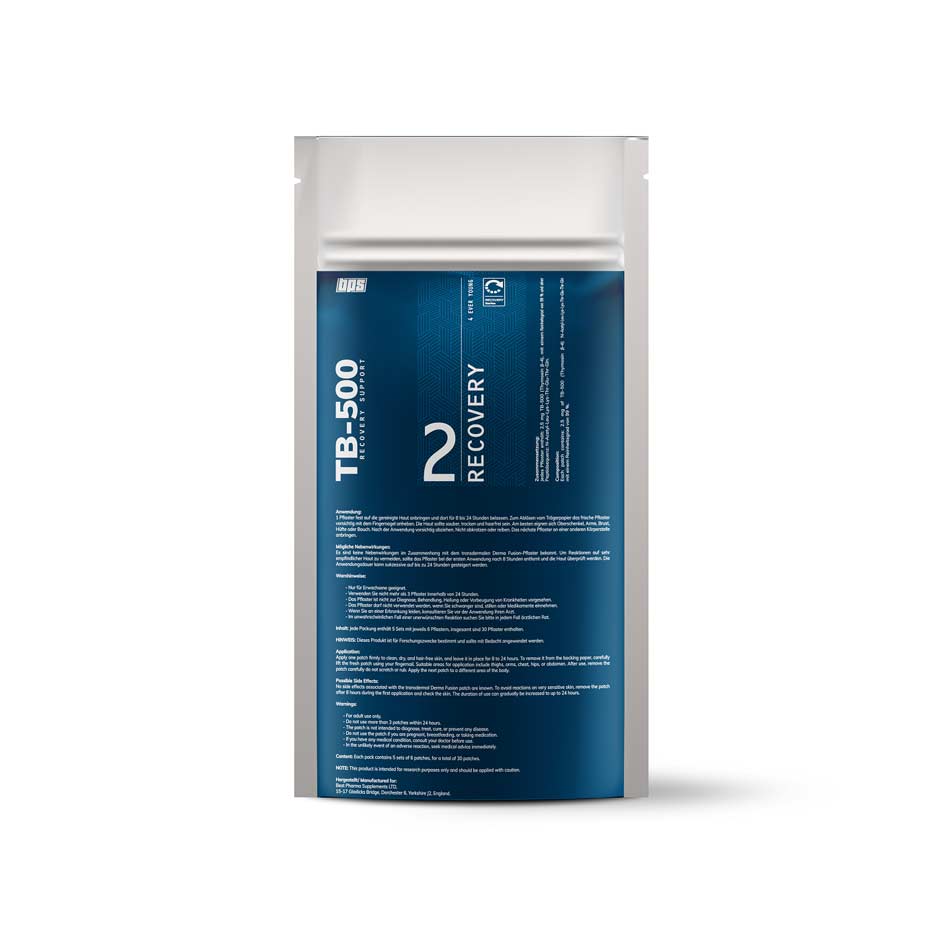What is TB-500?
TB-500 is a synthetic peptide. "Synthetic" means it doesn't occur in the body, but is produced in the laboratory. However, it is biologically derived, as TB-500 is a kind of "twin" of the protein thymosin beta-4 (Tβ4). This protein is found in the cell structures of all human tissue types. It has the property of preventing the migration of macrophages into inflammation sites in the extracellular space. In other words, it has a strong anti-inflammatory effect because it suppresses the immune system's response to tissue damage [1].
In 1981, thymosin beta-4 was artificially reproduced for the first time [2]. The artificial Tβ4 version was named "TB-500": It did not correspond 100% to the protein thymosin beta-4, which consists of a total of 43 amino acids (TB-500 consists of only 7 amino acids); despite this—or perhaps because of this—it was extremely effective in terms of its immunomodulatory effect. Even more effective than biological thymosin beta-4.
However, it took about 30 years after its initial synthesis until a special property of TB-500 emerged: TB-500 can significantly accelerate wound healing and tissue regeneration. This first became apparent in horse racing. Racehorses treated with a TB500 injection from veterinary medicine showed much better recovery after strenuous races and virtually eliminated problems with inflamed tendons or joints. It's no wonder that new doping testing procedures subsequently became established for horse racing [3].
How does TB-500 work?
TB-500 binds actin – a protein that is responsible, among other things, for the formation of connective tissue. Because TB-500 effectively "holds" this protein in place wherever repair is required, tissue repairs proceed significantly faster than under normal circumstances. This applies not only to connective tissue repairs. According to studies and the TB-500 experience of athletes, the peptide also promotes the regeneration and healing of
- skeletal muscles [4],
- Heart muscle tissue [5],
- collagen-containing tissue (such as skin, tendons and cartilage) [6],
- blood vessels [7] and
- hair follicles.
Furthermore, TB-500 appears to improve blood sugar control and increase insulin sensitivity.
TB-500 for injuries
The spectrum of effects defined above makes TB-500 the perfect remedy (or rather, a healing accelerator) for muscle tears, strains, bruises, tendonitis, tendon sprains or ruptures, ligament injuries, cuts, and burns. It is also said to be effective against the formation of unsightly scars after major skin injuries and after surgery.
TB-500 for regeneration
Because it combats inflammatory processes, TB-500 prevents any muscle soreness or quickly relieves it. Overuse of tendons and ligaments, which often manifest as painful swelling after strenuous training sessions, can also be treated very effectively with TB-500.
TB-500 for muscle growth
The extent to which TB-500 promotes muscle building is controversial. On the one hand, the peptide has no effect on hormone levels, which is why it obviously can't be as anabolic as steroids, prohormones, or SARMs. On the other hand, it promotes tissue rebuilding after an injury—and training is essentially nothing more than intentional injury to muscle tissue. Therefore, it stands to reason that TB-500 has at least some muscle-building effect.
TB-500 for anti-aging
Due to its anti-inflammatory and tissue-regenerating effects, TB-500 is also interesting for anti-aging purposes, although this application is not yet a major focus for the peptide. Perhaps this is due to the fact that another anti-aging peptide, Epitalon, is already on the market and enjoys much greater popularity in terms of life extension [8].
TB-500 in bodybuilding
It's obvious that TB-500 is of great interest to bodybuilders: In hardly any other sport can musculoskeletal injuries have such devastating effects as in bodybuilding; a "healing accelerator" like TB-500 is very welcome. Canadian bodybuilder Chris Bumstead, for example, who returned to the Mr. Olympia stage in 2023 shortly after a bicep injury (and even won the title), will likely have experience with TB-500.
It should be noted, however, that TB-500 cannot help with complete muscle or tendon tears, at least not immediately. If a muscle has completely detached from the bone, it must be surgically reattached – there is no way around it. Without surgery, the muscle will grow back, but not at the site where it was torn. This can potentially result in permanent deformity. In professional bodybuilding, such a thing can mean the end of a career. In this respect, the immediate use of TB-500 after a muscle tear is actually counterproductive, as it carries the risk of the muscle growing "prematurely" in the wrong place. However, following surgery, using TB-500 to accelerate the healing process is certainly beneficial.
In addition to being used as a healing agent after an injury, TB 500 can also be used in bodybuilding purely for prophylaxis or to stabilize tendons and ligaments. Bodybuilders who use anabolic steroids, in particular, would be well advised to occasionally consider prophylactic use of TB 500. On the one hand, their supraphysiological physical strength generally puts them at a high risk of tendon injuries, and on the other hand, certain steroids, such as stanozolol, make tendons brittle.
TB-500 Dosage
TB-500 is preferably administered as an injection, either subcutaneously or intramuscularly. The dosage varies depending on the intended use. In the few human studies conducted with TB-500 to date, doses between 2 mg and 5 mg twice weekly were used.
However, injectable TB-500 is difficult to obtain; oral preparations are much easier to obtain. These usually contain 500 mcg (half a milligram) of active ingredient per capsule. To achieve a weekly dose of at least 4 mg, you would need to take eight capsules weekly. However, twice the amount is certainly more effective. Transdermal patches, i.e., skin patches, are now also available (exclusively from BPS Pharma). Each patch contains 2.5 mg of TB-500. A single patch should be applied two to three times a week. The advantage of the patches over capsules is that you can determine their local application. While TB-500 has a systemic effect (i.e., throughout the entire body), according to users' experiences with TB-500, the patches are significantly more effective for local inflammation when applied directly to the inflamed area.
What are the side effects of TB-500?
The peptide TB-500 is still the subject of medical research, and a final safety assessment is not yet available. This means that the spectrum of side effects has not yet been determined. In other words: Whether TB-500 has side effects is unknown. In human trials with biological thymosin beta-4, no serious side effects were observed up to a dosage of 1,260 mg [9] – however, TB-500 is not completely identical to thymosin beta-4. The very mild side effects that occurred occasionally were
- Dizziness immediately after administration,
- Fatigue/lethargy,
- Headaches and
Nausea.
It should be noted that the peptide was administered exclusively by injection in the studies. There is currently no information at all on the side effects of oral preparations and patches.
Is TB-500 legal?
Regarding legality, TB-500 is not yet approved as a medicine or dietary supplement for humans in any country. However, it is still permitted to be sold – as a so-called "research chemical." This means that it may only be purchased for experimental purposes, and its use on humans (including personal consumption) is prohibited.
Athletes must also know that TB-500 is on theWADA List of Prohibited SubstancesIn doping tests, previous use can therefore lead to a positive test result. Especially in Germany, TB-500 is also considered a doping agent within the meaning ofAnti-Doping Act (AntiDopG), which prohibits possession of TB-500 in a “not insignificant quantity”.
Where can I buy TB-500?
Oral preparations containing TB-500 are available in well-stocked online stores, as are TB-500 patches. But be careful: Some products labeled "TB-500" actually contain the biological protein thymosin beta-4. As explained at the beginning, however, TB-500 is not identical to thymosin beta-4. In fact, TB-500 is only a synthetically produced segment of the biological amino acid chain that lies behind the protein thymosin beta-4, specifically segments 17-23 in the 43-part sequence of TB-4. Therefore, when purchasing a TB-500 product, the label should not list "Thymosin beta-4" under "Ingredients," but rather "TB-500" or "Frag. 17-23 of Thymosin B4."
- Allan L Goldstein et al. (2011): "Thymosin β4: a multi-functional regenerative peptide. Basic properties and clinical applications" - Expert Opin Biol Ther. 2012 Jan (https://pubmed.ncbi.nlm.nih.gov/22074294/)
- wikipedia.org: Thymosins (https://de.wikipedia.org/wiki/Thymosin)
- Emmie NM Ho (2012): “Doping control analysis of TB-500, a synthetic version of an active region of thymosin β₄, in equine urine and plasma by liquid chromatography-mass spectrometry” – J Chromatogr A.2012 Nov. (https://pubmed.ncbi.nlm.nih.gov/23084823/)
- CF Spurney et al. (2010): “Evaluation of Skeletal and Cardiac Muscle Function after Chronic Administration of Thymosin β-4 in the Dystrophin Deficient Mouse” – Published online 2010 Jan (https://www.ncbi.nlm.nih.gov/pmc/articles/PMC2813286/)
- Geir Bjørklund et al. (2020): “Thymosin β4: A Multi-Faceted Tissue Repair Stimulating Protein in Heart Injury” – Curr Med Chem. 2020
(https://pubmed.ncbi.nlm.nih.gov/31333080/) - H. Paul Ehrlich et al. (2010): “Thymosin beta4 enhances repair by organizing connective tissue and preventing the appearance of myofibroblasts” – Ann NY Acad Sci. 2010 (https://pubmed.ncbi.nlm.nih.gov/20536458/)
- Teresa Trenkwalder et al. (2015): “Thymosin-β4-mediated therapeutic neovascularization: role of the PI3K/AKT pathway” – Expert Opin Biol Ther. 2015 (https://pubmed.ncbi.nlm.nih.gov/25652683/)
- gannikus.de (2023): Epitalon – the peptide for anti-aging and longevity? (https://www.gannikus.de/medizin/epitalon-peptid-fuer-langlebigkeit-undanti-aging/)
- peptides.org: TB-500 | Reviews, Clinical Trials, and Safety (https://www.peptides.org/tb-500/)

















